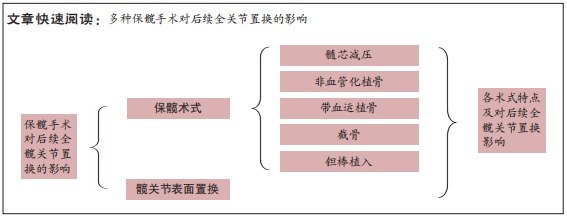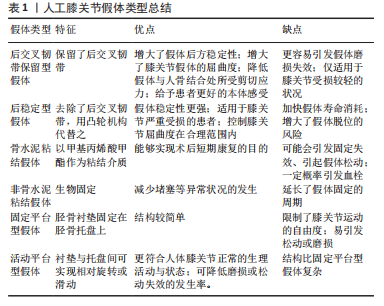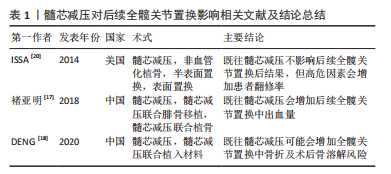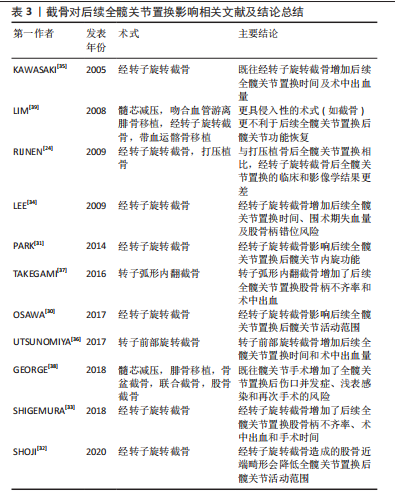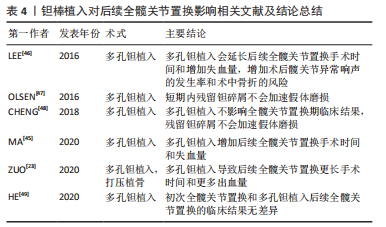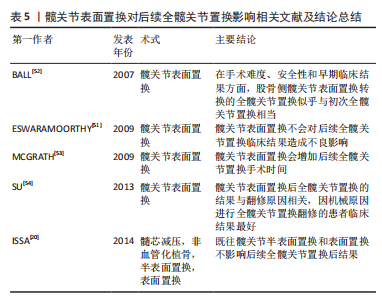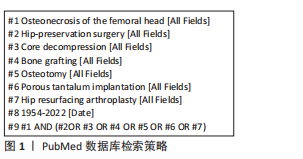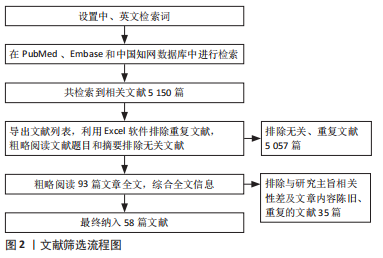[1] ZHAO D, ZHANG F, WANG B, et al. Guidelines for clinical diagnosis and treatment of osteonecrosis of the femoral head in adults (2019 version). J Orthop Transl. 2020;21:100-110.
[2] LEARMONTH ID, YOUNG C, RORABECK C. The operation of the century:total hip replacement. Lancet. 2007;370(9597):1508-1519.
[3] ZHAO DW, YU M, HU K, et al. Prevalence of nontraumatic osteonecrosis of the femoral head and its associated risk factors in the chinese population: results from a nationally representative survey. Chin Med J (Engl). 2015; 128(21):2843-2850.
[4] TAN B, LI W, ZENG P, et al. Epidemiological study based on china osteonecrosis of the femoral head database. Orthop Surg. 2021;13(1): 153-160.
[5] 赵德伟,谢辉. 成人股骨头坏死保髋手术治疗的策略及探讨[J].中国修复重建外科杂志,2018,32(7):792-797.
[6] 郭玉玲.中国人均预期寿命时空变化及影响因素分析[J].中国卫生政策研究,2018,11(8):44-49.
[7] HUANG ZQ, FU FY, LI WL, et al. Current treatment modalities for osteonecrosis of femoral head in mainland China: a cross-sectional study. Orthop Surg. 2020;12(6):1776-1783.
[8] 朱诗白,张啸天,陈曦,等.股骨头坏死的保髋治疗[J].中华关节外科杂志(电子版),2020,14(6):741-746.
[9] 刘予豪,周驰,陈雷雷,等.基于股骨头坏死围塌陷期理论的保髋术式总结[J].中国修复重建外科杂志,2017,31(8):1010-1015.
[10] HERNIGOU P, DUBORY A, HOMMA Y, et al. Cell therapy versus simultaneous contralateral decompression in symptomatic corticosteroid osteonecrosis:a thirty year follow-up prospective randomized study of one hundred and twenty five adult patients. Int Orthop. 2018;42(7):1639-1649.
[11] OSAWA Y, SEKI T, OKURA T, et al. Long-term outcomes of curved intertrochanteric varus osteotomy combined with bone impaction grafting for non-traumatic osteonecrosis of the femoral head. Bone Joint J. 2021; 103-B(4):665-671.
[12] MARTINOT P, DARTUS J, LECLERC JT, et al. Hip survival after plain core decompression alone versus bone morphogenetic protein and/or bone marrow reinjection with core decompression for avascular osteonecrosis of the femoral head: a retrospective case control study in ninety two patients. Int Orthop. 2020;44(11):2275-2282.
[13] LI M, MA Y, FU G, et al. 10-year follow-up results of the prospective, double-blinded, randomized, controlled study on autologous bone marrow buffy coat grafting combined with core decompression in patients with avascular necrosis of the femoral head. Stem Cell Res Ther. 2020;11(1),287.
[14] XIE H, WANG B, TIAN S, et al. Retrospective long-term follow-up survival analysis of the management of osteonecrosis of the femoral head with pedicled vascularized iliac bone graft transfer. J Arthroplasty. 2019;34(8): 1585-1592.
[15] XU Y, REN Y, ZHAO Z, et al. Hip survival rate in the patients with avascular necrosis of femoral head after transtrochanteric rotational osteotomy: a systematic review and meta-analysis. Chin Med J. 2019;132(24):2960-2971.
[16] AURÉGAN J, VILLAIN B, BÉGUÉ T. What is the rate of patients undergoing a total hip arthroplasty after core decompression and insertion of a tantalum rod in osteonecrosis of the femoral head: a systematic review. Int Orthop. 2018;42(7):1631-1638.
[17] 褚亚明,张亮,张金庆,等.全髋关节置换治疗保髋失败的非创伤性股骨头缺血性坏死的中期随访结果[J].中华骨与关节外科杂志,2018, 11(8):596-599.
[18] DENG W, WANG Z, ZHOU Y, et al. Does prior core decompression have detrimental effect on subsequent total hip arthroplasty for osteonecrosis of the femoral head: a systematic review and meta-analysis. Orthop Traumatol Surg Res. 2020;106(8):1553-1560.
[19] SINGH JA, SCHLECK C, HARMSEN S, et al. Clinically important improvement thresholds for Harris Hip Score and its ability to predict revision risk after primary total hip arthroplasty. BMC Musculoskelet Disord. 2016;17:256.
[20] ISSA K, JOHNSON AJ, NAZIRI Q, et al. Hip osteonecrosis: does prior hip surgery alter outcomes compared to an initial primary total hip arthroplasty? J Arthroplasty. 2014;29(1):162-166.
[21] 陈铭璁,傅煊健,陈扬.股骨头减压非血管化植骨保头手术进展[J].中国骨与关节损伤杂志,2020,35(10):1115-1116.
[22] 蔡剑,岳永彬,孙海忠,等.股骨头坏死异体腓骨移植失败后的全髋关节置换[J].东南大学学报(医学版),2018,37(4):588-593.
[23] ZUO W, MA JH, CUI W, et al. Comparison of total hip arthroplasty after two types of failed hip preserving procedures with primary total hip arthroplasty. Orthop Surg. 2020;12(1):162-169.
[24] RIJNEN WHC, LAMEIJN N, SCHREURS BW, et al. Total hip arthroplasty after failed treatment for osteonecrosis of the femoral head. Orthop Clin North Am. 2009;40(2):291-298.
[25] 丁海波,王阳,陆芸.带血管骨移植治疗股骨头坏死的研究进展[J].中国修复重建外科杂志,2021,35(3):381-386.
[26] BEREND KR, GUNNESON E, URBANIAK JR, et al. Hip arthroplasty after failed free vascularized fibular grafting for osteonecrosis in young patients. J Arthroplasty. 2003;18(4):411-419.
[27] DAVIS ET, MCKEE MD, WADDELL JP, et al. Total hip arthroplasty following failure of free vascularized fibular graft. J Bone Joint Surg Am. 2006;88 Suppl 3:110-115.
[28] RYAN SP, WOOSTER B, JIRANEK W, et al. Outcomes of conversion total hip arthroplasty from free vascularized fibular grafting. J Arthroplasty. 2019; 34(1):88-92.
[29] CHAU W, NG JP, LAU H, et al. Osteonecrosis of the hip: is there a difference in the survivorship of total hip arthroplasty with or without previous vascular iliac bone grafting? J Orthop Surg Res. 2021;16(1):244.
[30] OSAWA Y, SEKI T, MORITA D, et al. Total hip arthroplasty after transtrochanteric rotational osteotomy for osteonecrosis of the femoral head: a mean 10-year follow-up. J Arthroplasty. 2017;32(10):3088-3092.
[31] PARK KS, TUMIN M, PENI I, et al. Conversion total hip arthroplasty after previous transtrochanteric rotational osteotomy for osteonecrosis of the femoral head. J Arthroplasty. 2014;29(4):813-816.
[32] SHOJI T, YAMASAKI T, OTA Y, et al. Effect of transtrochanteric rotational osteotomy on impingement and contact state of a femoral implant in conversion total hip arthroplasty-Retrospective simulation study. Clin Biomech (Bristol, Avon). 2020;71:68-72.
[33] SHIGEMURA T, YAMAMOTO Y, MURATA Y, et al. Total hip arthroplasty after failed transtrochanteric rotational osteotomy for osteonecrosis of the femoral head: a systematic review and meta-analysis. Orthop Traumatol Surg Res. 2018;104(8):1163-1170.
[34] LEE YK, HA YC, KIM KC, et al. Total hip arthroplasty after previous transtrochanteric anterior rotational osteotomy for femoral head osteonecrosis. J Arthroplasty. 2009;24(8):1205-1209.
[35] KAWASAKI M, HASEGAWA Y, SAKANO S, et al. Total hip arthroplasty after failed transtrochanteric rotational osteotomy for avascular necrosis of the femoral head. J Arthroplasty. 2005;20(5):574-579.
[36] UTSUNOMIYA T, MOTOMURA G, IKEMURA S, et al. The results of total hip arthroplasty after sugioka transtrochanteric anterior rotational osteotomy for osteonecrosis. J Arthroplasty. 2017;32(9):2768-2773.
[37] TAKEGAMI Y, KOMATSU D, SEKI T, et al. Total hip arthroplasty after failed curved intertrochanteric varus osteotomy for avascular necrosis of the femoral head. Nagoya J Med Sci. 2016;78(1):89-97.
[38] GEORGE J, MILLER EM, HIGUERA CA, et al. Influence of prior hip salvage surgery on outcomes after total hip arthroplasty in young patients. J Arthroplasty. 2018;33(4):1108-1112.
[39] LIM S, MOON Y, EUN S, et al. Total hip arthroplasty using the s-rom modular stem after joint-preserving procedures for osteonecrosis of the femoral head. J Arthroplasty. 2008;23(4):495-501.
[40] YANG Z, JIAN W, LI ZH, et al. The geometry of the bone structure associated with total hip arthroplasty. PLoS One. 2014;9(3):e91058.
[41] 朱东明,张振,张杰,等.全髋关节置换后假体脱位危险因素的最新进展[J]中国组织工程研究,2020,24(36):5864-5870.
[42] BEVERLAND DE, O’NEILL CKJ, RUTHERFORD M, et al. Placement of the acetabular component. Bone Joint J. 2016;98BA(1):37-43.
[43] FOTTNER A, WOICZINSKI M, KISTLER M, et al. Varus malalignment of cementless hip stems provides sufficient primary stability but highly increases distal strain distribution. Clin Biomech (Bristol, Avon). 2018;58:14-20.
[44] HAVERSATH M, BUSCH A, JAGER M, et al. The ‘critical trochanter angle’: a predictor for stem alignment in total hip arthroplasty. J Orthop Surg Res. 2019;14(1):165.
[45] MA J, WANG B, YUE D, et al. Outcomes of conversion tha after failed porous tantalum implant for osteonecrosis of the femoral head:a comparative matched study. HIP International. 2020;30(6):703-710.
[46] LEE G, PARK K, KIM D, et al. Results of total hip arthroplasty after core decompression with tantalum rod for osteonecrosis of the femoral head. Clin Orthop Surg. 2016;8(1):38-44.
[47] OLSEN M, LEWIS PM, MORRISON Z, et al. Total hip arthroplasty following failure of core decompression and tantalum rod implantation. Bone Joint J. 2016;98-B(9):1175-1179.
[48] CHENG Q, TANG J, GU J, et al. Total hip arthroplasty following failure of tantalum rod implantation for osteonecrosis of the femoral head with 5- to 10-year follow-up. BMC Musculoskel Disord. 2018;19(1):289.
[49] HE M, WEI Q, CHEN Z, et al. Porous tantalum rod implantation is associated with low survival rates in patients with type C2 osteonecrosis of the femoral head but has no effect on the clinical outcome of conversion total hip arthroplasty: a retrospective study with an average 8-year follow-up. BMC Musculoskel Disord. 2020;21(1):841.
[50] MARSH M, NEWMAN S. Trends and developments in hip and knee arthroplasty technology. J Rehabil Assist Technol Eng. 2021;8:2055668320952043.
[51] ESWARAMOORTHY VK, BIANT LC, FIELD RE. Clinical and radiological outcome of stemmed hip replacement after revision from metal-on-metal resurfacing. J Bone Joint Surg Br. 2009;91(11):1454-1458.
[52] BALL ST, LE DUFF MJ, AMSTUTZ HC. Early results of conversion of a failed femoral component in hip resurfacing arthroplasty. J Bone Joint Surg Am. 2007;89(4):735-741.
[53] MCGRATH MS, MARKER DR, SEYLER M, et al. Surface replacement is comparable to primary total hip arthroplasty. Clin Orthop Relat Res. 2009; 467(1):94-100.
[54] SU EP, SU SL. Surface replacement conversion: results depend upon reason for revision. Bone Joint J. 2013;95-B(11 Suppl A):88-91.
[55] 顾长源,杜斌,孙光权,等.股骨头坏死保髋治疗常用术式的利与弊. 中国组织工程研究,2020,24(21):3379-3386.
[56] FEHRLE MJ, CALLAGHAN JJ, CLARK CR, et al. Uncemented total hip arthroplasty in patients with aseptic necrosis of the femoral head and previous bone grafting. J Arthroplasty. 1993;8(1):1-6.
[57] BOACHIE-ADJEI Y, KO JK, CUI Q. Total hip arthroplasty after failed operative treatment for osteonecrosis of the femoral head. Seminars in Arthroplasty. 2008;19(4):267-273.
[58] PIERCE TP, ELMALLAH RK, JAUREGUI JJ, et al. Outcomes of total hip arthroplasty in patients with osteonecrosis of the femoral head-a current review. Curr Rev Musculoskelet Med. 2015;8(3):246-251.
|
